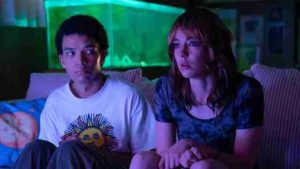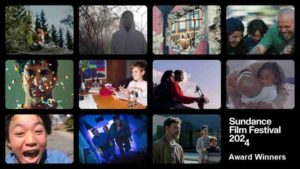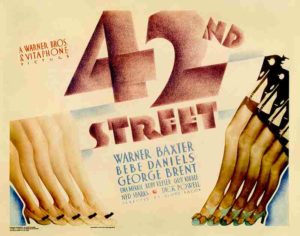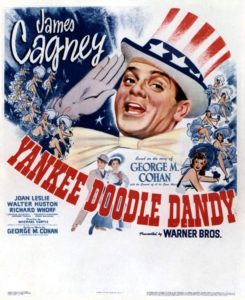In advance of this upcoming 96th annual Academy Awards ceremony — which begins at 4pm this Sunday, an hour earlier than usual — please find trailers for the ten 2023 films garnering recognition in Hollywood as the best films of the year.




In advance of this upcoming 96th annual Academy Awards ceremony — which begins at 4pm this Sunday, an hour earlier than usual — please find trailers for the ten 2023 films garnering recognition in Hollywood as the best films of the year.




Every three decades, or roughly once a generation, Hollywood experiences a seismic shift. The transition from silent films to talkies in the 1920s. The rise of broadcast television in the 1950s. The raucous cable boom of the 1980s.
It’s been happening again, for some while now, as most folks have observed.
The long-promised streaming revolution — the next great leap in how the world gets its entertainment — is finally here in all its glory.

Warner Bros. Discovery studio in Burbank, Califoria, one of the oldest and largest Hollywood studios
In the 115-year history of the American film industry, never has so much upheaval arrived so fast and on so many fronts, leaving many writers, directors, studio executives, agents and other movie workers disoriented and demoralized. These are melodramatic people by nature, but talk to enough of them and you will get the strong sense that their fear is real this time.
“The last four years have shaken the movie business to its bones,” Jason Blum, the powerhouse producer whose credits range from The Purge series to Get Out and the BlacKkKlansman.” recently told Los Angeles Times film writer, Justin Chang.

Streaming, of course, has been disrupting the entertainment business for some time. Netflix started delivering movies and TV shows via the internet in 2007.
In 2024, however, the shift towards streaming has greatly accelerated, with Netflix, Disney+, Apple TV, Crave/HBO, Prime Video, YouTube Premium, CBC Gem and Kanopy, among other streaming platforms, competing for your movie attention.

Adding to Hollywood’s misery is the abrupt changing of the guard in Hollywood’s highest ranks. Nine of the top 20 most powerful people in show business have left their jobs, including Universal’s Ron Meyer, whose 25-year Universal career ended in 2021. David Zaslav is now in firm control of Warner Bros. Discovery, with Kevin Tsujihara exiting his role as chairman and CEO of Warner Bros. Entertainment, a job he held for six years. Paramount Global CEO Jim Gianopulos was removed, in favour of Bob Bakish, also now on the way out, with the company up for sale.
“It’s not clear that full normal will return even well into the fourth quarter of 2024,” Warner Bros. Discovery Chairman David Zaslav, told Chang in an interview on how Hollywood is faring against the streaming wars, and the slow recovery from the pandemic.

An empty cinema with no patrons. Is this picture an indication of what presages cinema in the future?
Will young people — trained during the pandemic to expect instant access to new movies — get into the habit of going to the movies like their parents and grandparents did? Generation Z forms a crucial audience: About 33% all moviegoers in 2023 were under the age of 24, according to the Motion Picture Association.
“Cinema as an art form is not going to die,” Michael Shamberg, the producing force behind films like Erin Brockovich and The Big Chill” told the New York Times’ Manohla Dargis in a recent interview. “But the tradition of cinema that we all grew up on, falling in love with movies in a theatre, is over.”
In other words, the art may live on, but the myth of big screens as the be-all and end-all is being dismantled in a fundamental and perhaps irreversible manner.


There were a smattering of big sales and buzzy premières at this year’s 40th edition of the Sundance Film Festival, held each January since 1984 in Park City, Utah.
Even so, it’s impossible to ignore the fact that the independent film business Sundance has so long championed is suffering from an identity crisis.
The box office for art-house movies has yet to regain its pre-COVID stride.
Desperate for content, streaming services once paid inflated prices for films débuting at Sundance . Now they’re conservative in their spending.
In this era of economizing, the all-night bidding wars that made Sundance sizzle are a thing of the past, not a great sign of the financial health of the industry.
Yet there was still plenty to celebrate.
Movies like Super/Man: The Christopher Reeve Story and Will & Harper received emotional standing ovations, while A Real Pain and It’s What’s Inside defied the odds to score multimillion-dollar deals.
As it enters its fifth decade, Sundance hasn’t lost its ability to excite audiences.
But, clearly, Sundance needs to make adjustments to the way it conducts itself in order to keep up with the changing times, if the indie festival is going to survive.
 Actor / Oscar nominee, first time director Jesse Eisenberg and Kieran Culkin star in A Real Pain
Actor / Oscar nominee, first time director Jesse Eisenberg and Kieran Culkin star in A Real Pain
A Real Pain, starring Jesse Eisenberg and Kieran Culkin as cousins who travel to their grandmother’s native Poland to partake in a Holocaust tour, scored rave reviews and won the Waldo Salt Screenwriting Award for Eisenberg, the film picked up by Searchlight for a whopping $10 million early on in the Festival. A Real Pain will receive a theatrical release later this year, and may be Oscar bound next year.

Focus Features snatched up Sundance favourite Dìdi, directed by Academy Award nominee Sean Wang, the film telling the story of a 13-year-old Taiwanese American boy (Izaac Wang) who spends his last summer before high school learning how to flirt, skate, and get along with his mom (Joan Chen). Dìdi, set in 2008, won Sundance’s Audience Award and the Special Jury Prize drama award.
 Richard Roundtree and June Squibb star in director Josh Margolin’s ode to his grandma, Thelma
Richard Roundtree and June Squibb star in director Josh Margolin’s ode to his grandma, Thelma
Magnolia Pictures snagged the elderly-buddy comedy Thelma, the tale of a 93-year-old grandma (June Squibb) who endures a harrowing journey across Los Angeles after she’s conned by a phone scammer pretending to be her grandson (Fred Hechinger). The film also stars Richard Roundtree as her companion, as the two seeking retribution. Parker Posey, Clark Gregg, and Malcolm McDowell co-star.

The documentary Super/Man: The Christopher Reeve Story, which sold for $15 million to Warner Bros. Discovery, follows Christopher Reeve on how he found his life’s purpose after he suffered from an equestrian accident that left him paralyzed.
 Maisy Stella and Aubrey Plaza star in Canadian director Megan Park’s new film, My Old Ass
Maisy Stella and Aubrey Plaza star in Canadian director Megan Park’s new film, My Old Ass
Director Megan Park’s My Old Ass will head directly to Amazon’s Prime Video this spring, the film telling the story of high-school senior (Maisy Stella), who meets the adult version of herself (Aubrey Plaza) right before she heads off to college.

Skywalkers: A Love Story, directed by Jeff Zimbalist, was acquired by Netflix. The documentary follows Angela Nikolau and Ivan Beerkus, a couple from Moscow, who saved their careers and relationship by climbing really tall buildings, specifically the world’s last super skyscraper, to perform an acrobatic stunt.
The Will Ferrell documentary Will & Harper was also picked up by Netflix, the road trip film about two Saturday Night Live alumni, Ferrell and former SNL head writer Harper Steele, who reconnect after Steele comes out as a trans woman. The duo set out together for a cross-country trip, during which they talk in depth about their friendship and the experience of being trans in America.
Sundance hasn’t been a Festival that’s been synonymous with Academy Awards attention, though recent iterations have churned out Oscar favourites like Best Picture winner CODA, Lee Isaac Chung’s semi-autobiographical Minari, and Korean-Canadian director Celine Song’s wistful dramatic début, Past Lives.
Although A Real Pain and Super/Man were critically embraced, there’s a question as to whether they have enough buzz to stay in the conversation until next year.
What Sundance may have lacked in stature this year, it made up for in scares.
Steven Soderbergh’s twisty thriller Presence, which Vulture critic Bilge Ebiri wrote is “the best thing Soderbergh’s done in ages,” is a haunted-house movie seen through the eyes of the ghost. Neon picked up the film’s distribution rights.
Zombie slasher movie In a Violent Nature and other movies about things that go bump in the night were all the rage in Park City.

It’s What’s Inside, a horror story about a pre-wedding party from hell, landed at Netflix in a massive $17 million sale. Along with the haunted psychodrama I Saw the TV Glow — which arrived at Sundance having secured theatrical distribution from A24 — both films became this year’s conversation starters on Main Street.

Justice Smith and Brigette Lundy-Paine star in writer-director Jane Schoenbrun’s I Saw the TV Glow
Nothing beats a good fright.

In the Summers, an independent film about two sisters navigating fraught summer visits with their father, won the Grand Jury Prize at this year’s Festival, as well as Best Director for Alessandra Lacorazza.

Shuchi Talati’s début feature, Girls Will Be Girls, about a mother’s intervention in her teenage daughter’s budding romance that creates an unexpected emotional love triangle, landed the Audience Award for World Cinema, as well as the World Cinema Dramatic Special Jury Award for Acting, for Preeti Panigrahi.

Porcelain War landed the award for U.S. Documentary Grand Jury Prize for Brendan Bellomo and Slava Leontyev, the film an intimate reflection on making art in wartime Ukraine.

The U.S. Documentary directing award was awarded to Julian Brave NoiseCat and Emily Kassie for Sugarcane, an enlightening and infuriating look into systematic abuse at an Indian Residential School.

The World Cinema Documentary directing award went to Benjamin Ree for Ibelin, which focuses on Norwegian gamer Mats Steen. Steen’s parents mourned what they thought had been a lonely and isolated life after their son died of a rare, degenerative muscular disease at age 25. They later received messages from online friends all around the world who knew Steen for his beloved World of Warcraft avatar, Ibelin Redmoore.

All the films mentioned in today’s VanRamblings column will find their way onto your local multiplex screen at some point this year, or are scheduled to air on Netflix, Prime Video or another streamer.


Movie musicals are often a polarizing topic.
People either love them or hate them, and even those that love them are critical of on-screen adaptations of their favourite stage shows.
In recent years, Hollywood hasn’t had a great track record of adapting musicals from the stage to the screen in a way that works, and many movie musicals in past years have been criticized for not having that certain something that makes the onstage musicals feel so special and unique.
That was the case until three years ago, 2021, which apparently became the year when Hollywood figured out how to make a good movie musical.
As the musicals that were made that year were, sadly, not big box office hits, nor successful streaming, movie musicals have once again faded from our screens, both in our local multiplex, and on Netflix and other streaming platforms.
Still and all, if you love musicals, you can still take heart with the rich and glorious history of the musical, in whatever form it has taken cinematically.
Regardless of their box office success, there were there a great many 2021 musicals that were Oscar nominated — In The Heights, Dear Evan Hansen, tick, tick…BOOM!, West Side Story, and even Encanto (which wasn’t derived from a stage play). For the most part, they were well executed, and loved by critics, if not by a mass, anticipatory audience.
For the past century, the Hollywood musical has been recognized as a distinguished part of our movie history, playing an integral role in the evolution of movies during the 1920s through 1950s, til now.
It wasn’t until 1927 that Warner Brothers first introduced to the big screen singing along with sound in their release of The Jazz Singer; a remake of the Broadway musical of the same name.
The late 1920s brought difficult economic times, and a worldwide Depression.
It was during this time that Hollywood came to the public’s rescue with the dynamically entertaining diversion of the Hollywood musical.
Hollywood studios began to release a plethora of musicals which offered the movie-going public a chance to temporarily escape from the dire economic issues that had the world in its grip.

In the 1930s, with Warner Brothers’ acquisition of choreographer Busby Berkeley, the musical genre was truly born with the release of popular musicals like 42nd Street, Bright Lights, and Gold Diggers.
Capping the decade was 1939’s The Wizard of Oz, still one of the classic musicals that continues to entertain audiences today.
It was during the 1940s that the Hollywood musical really came of age, and the popularity of the movie musical continued right through the 1950s.

One of the more popular 1940s musicals was Yankee Doodle Dandy, a film that introduced movie lovers to a young James Cagney who gave a performance that earned him an Oscar. Another popular 1940s title, long a holiday tradition, is The Bells of St. Mary’s.
Metro-Goldwyn-Mayer embraced old-fashioned musical films in the ’40s and ’50s, furthering the boundaries of the musicals, with stars like Judy Garland, Fred Astaire and Mickey Rooney leading the way.
Starting with Meet Me in St. Louis (Vincent Minnelli, 1944), MGM began producing some of the most popular films of the era, including Easter Parade (Walters, 1948), An American in Paris (Minnelli, 1951), and Singin’ in the Rain (Kelly and Donen, 1952).
Marilyn Monroe brought a new element to the musical movie during the 1950’s.
This was also the time to bring Broadway to film in movies such as Oklahoma! and Guys and Dolls.
Elvis also started to make the big screen his home, which many believe signalled the beginning of the end for the genre.
Through the 1960s, though, the adaptation of stage material for the screen remained a predominant trend in Hollywood. West Side Story, My Fair Lady, The Sound of Music, and Oliver! were all adapted from Broadway hits and each won the Academy Award for Best Picture.
The genre changed slightly during the 1970’s, where in some cases, such as Saturday Night Fever and Tommy, the stars were not the singers. The movie plot was being driven by song, but in a pre-recorded way.
There were a few musicals to note in the ’80s, like Annie and Purple Rain, but for the most part, the entire genre had changed to musicians supplying the music.
With the arrival of the early 1990s, one of the more successful modern-day musical movements emerged: Disney’s animated musical blockbusters, including such films as The Little Mermaid, Aladdin and The Lion King, all released in rapid succession, amassing an enormous fan base along the way.
In 2000, let us not forget the Coen Brothers’ O Brother, Where Are Thou?
Although the animated musical film has become a popular route for the genre in recent years, the success of musicals like Chicago, Rent, Sweeney Todd, and Les Misérables seems to indicate that large scale, live action musical productions are still very much relevant to film today.
In 2006: John Carney’s début film, Once, with Glen Hansard and Markéta Irglová.
In 2017, three musicals were nominated for Best Motion Picture – Musical or Comedy at the Golden Globes: Florence Foster Jenkins, La La Land, and Sing Street, with La La Land taking home the award (well, sort of).
Although musicals might not necessarily find success in terms of receiving the most awards recognition, they are nonetheless popular and enjoyed by audiences.
Once upon a time, huge, spectacle musicals were the backbone of Hollywood.
The pandemic year of 2021 offered Hollywood a chance to return to the glory days of the 1930s Depression era musical, allowing audiences to reacquire a taste for the musical, to help lift of us out of the malaise that had us in its grip.
The Hollywood musical has always offered viewers a page out of movie history, memories that will forever be captured on film, and musical films that will continue to be enjoyed by audiences around the world.